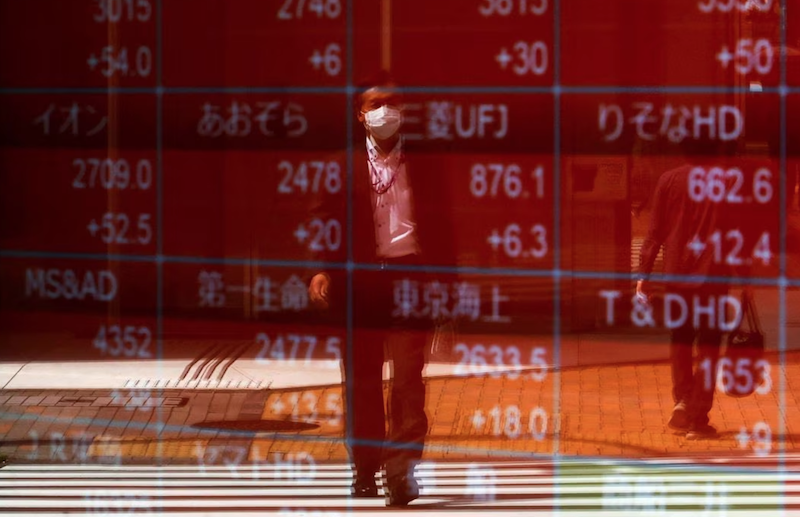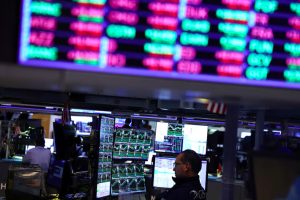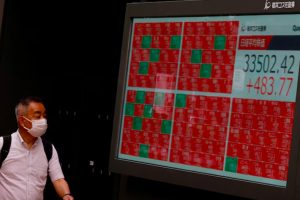Asian stocks were in retreat on Thursday, knocked back by new signs of sustained inflationary pressures in the United States and a slowing Chinese economy.
Wall Street stocks were sold off after US data showed its services sector had unexpectedly picked up steam in August, hinting at stubborn inflationary forces and boosting the case for elevated interest rates for longer.
That sapped the mood across the region and saw Japanese stocks snapping an eight-day winning streak, having reversed course after hitting a five-week peak earlier.
Also on AF: Global Finance System at Risk of a ‘Great Fracture’, UN Chief Warns
The Nikkei index closed 0.75% lower at 32,991.08, after hitting a high of 33,322.45 in morning trade. The broader Topix scaled a 33-year high of 2,397.33 in the morning but closed 0.38% lower at 2,383.38.
The indexes have, though, rallied strongly recently and are up more than 25% year-to-date, among the best-performing globally.
China’s August trade data came in better than some had expected but exports and imports both shrank following a fifth straight month of declining factory activity – a drawback for suppliers in Japan.
The weak yen, which hit a 10-month low of 147.87 to the dollar in morning trade, remains a source of support, however, for Japanese exporters, since it helps them compete globally.
Chinese shares fell on Thursday dragged lower by semiconductor stocks, while optimism over better-than-expected trade data capped those losses.
China’s exports fell 8.8% in August, while imports contracted 7.3%, increasing pressure on the country’s vast manufacturing sector as demand sags at home and abroad.
The declines for both imports and exports, however, narrowed from July, a positive surprise for the market. While the better-than-expected data came as a relief, more stimulus measures are needed to drive economic growth and lift market confidence, UBS analysts wrote in a note.
Meanwhile, the US Commerce Department should end all technology exports to Huawei and SMIC following the discovery of new chips in Huawei phones that may violate trade restrictions, the chair of the House of Representatives’ committee on China said on Wednesday.
Semiconductor stocks dropped 2.9% after a recent rally and were on track for the largest daily drop in over two months.
The Shanghai Composite Index lost 1.13%, or 35.72 points, to 3,122.35, while the Shenzhen Composite Index on China’s second exchange slipped 1.76%, or 34.73 points, to 1,936.86.
China Property Developers Drop
Mainland property developers traded in Hong Kong declined 1.4% after shares of Sunac China Holdings Ltd and Evergrande slipped after a wild rally in the past few sessions.
That rally came after two of China’s major state banks said they will start to lower the interest rates on existing mortgages for first-home loans.
The Hang Seng Index dropped 1.34%, or 247.91 points, to 18,202.07.
Elsewhere across the region, in early trade, Sydney, Seoul, Singapore, Taipei, Jakarta and Manila were all well down, while Mumbai edged ahead. MSCI’s broadest index of Asia-Pacific shares slid 0.68% after declines on Wall Street and in Europe.
US stock futures pointed to a 0.2% decline after a 0.7% slide for the S&P 500 overnight. German DAX futures were down 0.36% and UK FTSE futures slipped 0.26%.
Although traders are still fairly certain the Federal Reserve will forego a rate increase this month, they put the risk of one by year-end at closer to a coin toss. A rate cut is not expected until June.
The dollar index, which measures the currency against six developed-market peers, including the yen and euro, ticked up 0.07% to 104.93. It jumped to the highest since March 15 on Wednesday at 105.03.
The dollar earlier reached its strongest level since November 4 versus the yen at 147.875.
China Shores Up Yuan
The currency pair tends to move in step with long-term Treasury yields, which stood at 4.29% on Thursday after pushing to their highest since August 23 at 4.306% in the previous session.
Elsewhere, the People’s Bank of China continued its bid to shore up the yuan by again setting strong official midpoints for the currency.
Despite those efforts, the yuan continues to hover on the weaker side of the closely watched 7.3 per dollar level in offshore trading, last changing hands at 7.3332.
It sank to the lowest since early November at 7.3490 in the middle of last month, undercut by a rapidly deteriorating property sector and the risk of spillover into broader markets.
Crude paused its steady climb of the past two weeks during Asian hours on Thursday, as worries about Chinese demand offset some of the effects of expectations for a fall in US inventories and extended supply cuts by Saudi Arabia and Russia.
Brent crude futures fell 24 cents to $90.36 a barrel, after a nine-session winning streak. US West Texas Intermediate crude (WTI) futures fell 29 cents to $87.25 after a seven-session gain.
Key figures
Tokyo – Nikkei 225 < DOWN 0.75% at 32,991.08 (close)
Hong Kong – Hang Seng Index < DOWN 1.34% at 18,202.07 (close)
Shanghai – Composite < DOWN 1.13% at 3,122.35 (close)
London – FTSE 100 < DOWN 0.04% at 7,423.12 (0933 BST)
New York – Dow < DOWN 0.57% at 34,443.19 (Wednesday close)
- Reuters with additional editing by Sean O’Meara
Read more:
Huawei’s Chip Breakthrough ‘May Spur Tougher US Tech Curbs’
Foxconn Banking on Apple Lift After August Sales Drop
Property Surge Limits Hang Seng Losses, Weak Yen Lifts Nikkei
























